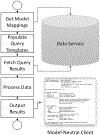Towards Co-Evolution of Data-Centric Ecosystems
- PMID: 37614739
- PMCID: PMC10445529
- DOI: 10.1145/3400903.3400908
Towards Co-Evolution of Data-Centric Ecosystems
Abstract
Database evolution is a notoriously difficult task, and it is exacerbated by the necessity to evolve database-dependent applications. As science becomes increasingly dependent on sophisticated data management, the need to evolve an array of database-driven systems will only intensify. In this paper, we present an architecture for data-centric ecosystems that allows the components to seamlessly co-evolve by centralizing the models and mappings at the data service and pushing model-adaptive interactions to the database clients. Boundary objects fill the gap where applications are unable to adapt and need a stable interface to interact with the components of the ecosystem. Finally, evolution of the ecosystem is enabled via integrated schema modification and model management operations. We present use cases from actual experiences that demonstrate the utility of our approach.
Keywords: application-database co-evolution; model management; schema evolution; software ecosystems.
Figures












References
-
- Bechhofer Sean, David De Roure Matthew Gamble, Goble Carole, and Buchan Iain. 2010. Research Objects: Towards Exchange and Reuse of Digital Knowledge. Nature Precedings (2010).
-
- Philip A Bernstein Jayant Madhavan, and Rahm Erhard. 2011. Generic Schema Matching, Ten Years Later. Proceedings of the VLDB Endowment 4, 11 (2011).
-
- Bugacov Alejandro, Czajkowski Karl, Kesselman Carl, Kumar Anoop, Schuler Robert E., and Tangmunarunkit Hongsuda. 2017. Experiences with DERIVA: An asset management platform for accelerating eScience. In Proceedings - 13th IEEE International Conference on eScience, eScience 2017. 79–88. - PMC - PubMed
-
- Chard K, D’Arcy M, Heavner B, Foster I, Kesselman C, Madduri R, Rodriguez A, Soiland-Reyes S, Goble C, Clark K, Deutsch EW, Dinov I, Price N, and Toga A. 2016. I’ll take that to go: Big data bags and minimal identifiers for exchange of large, complex datasets. In 2016 IEEE International Conference on Big Data (Big Data). 319–328.
Grants and funding
LinkOut - more resources
Full Text Sources
Research Materials
Miscellaneous
